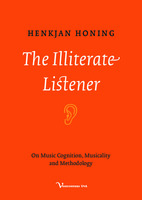The Illiterate Listener: On Music Cognition, Musicality and Methodology
| dc.contributor.author | Honing, Henkjan | |
| dc.date.accessioned | 2014-12-31 23:55:55 | |
| dc.date.accessioned | 2019-12-10 14:46:32 | |
| dc.date.accessioned | 2020-04-01T14:43:08Z | |
| dc.date.available | 2020-04-01T14:43:08Z | |
| dc.date.issued | 2011 | |
| dc.identifier | 480090 | |
| dc.identifier | OCN: 751962331 | en_US |
| dc.identifier.uri | http://library.oapen.org/handle/20.500.12657/33404 | |
| dc.description.abstract | We have known for some time that babies possess a keen perceptual sensitivity for the melodic, rhythmic and dynamic aspects of speech and music: aspects that linguists are inclined to categorize under the term ‘prosody’, but which are in fact the building blocks of music. Only much later in a child’s development does he make use of this ‘musical prosody’, for instance in delineating and subsequently recognizing word boundaries. In this essay Henkjan Honing makes a case for ‘illiterate listening’, the human ability to discern, interpret and appreciate musical nuances already from day one, long before a single word has been uttered, let alone conceived. It is the preverbal and preliterate stage that is dominated by musical listening. | |
| dc.language | English | |
| dc.subject.classification | thema EDItEUR::A The Arts::AV Music::AVA Theory of music and musicology | en_US |
| dc.subject.other | music | |
| dc.subject.other | cognition | |
| dc.title | The Illiterate Listener: On Music Cognition, Musicality and Methodology | |
| dc.type | book | |
| oapen.identifier.doi | 10.26530/OAPEN_480090 | |
| oapen.relation.isPublishedBy | dd3d1a33-0ac2-4cfe-a101-355ae1bd857a | |
| oapen.relation.isbn | 9789048526987 | |
| oapen.identifier.ocn | 751962331 |

